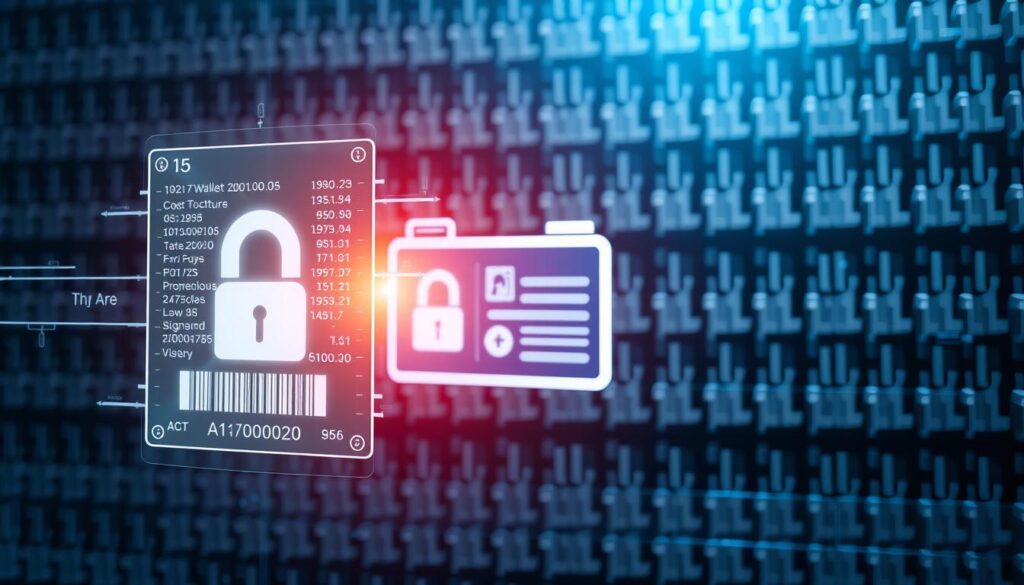Now Reading: Blockchain for Identity Verification: A How-to Guide
- 01
Blockchain for Identity Verification: A How-to Guide
Blockchain for Identity Verification: A How-to Guide

In today’s digital world, managing identity verification is a big challenge. Old methods like passwords and databases can’t keep up with cyber threats. Blockchain offers a new way to handle identity verification.
It keeps data safe and lets users control their info. This guide shows how blockchain can replace old systems, focusing on privacy and security.
Blockchain for identity verification uses a network to create unchangeable records. It’s different from old databases because it lowers fraud risks. For example, privacy-focused resources like privacy-enhancing blockchain tech show how it stops data breaches.
Key Takeaways
- Blockchain provides secure, decentralized identity verification systems.
- Traditional systems face vulnerabilities that blockchain can resolve.
- Users gain control over their personal data with blockchain solutions.
- Decentralized ledgers eliminate single points of failure in identity management.
- This guide outlines practical steps to implement blockchain-based verification.
Understanding the Identity Crisis in the Digital Age
Every day, millions face the risk of identity theft in our digital world. Stolen credit card details and fake social media accounts are common. Traditional methods can’t keep up with new cyber threats, leaving everyone at risk.
The Rising Incidents of Identity Theft
Reports of identity theft hit 492 million in 2022, says the Identity Theft Resource Center. The 2017 Equifax hack exposed 147 million records, showing big flaws. Hackers target weak spots in old systems, causing victims to lose time, money, and trust.
Limitations of Traditional Identity Verification Systems
Today’s systems use centralized databases, which hackers love to target. They have big weaknesses:
- Single points of failure (e.g., breached government databases)
- Lack of real-time updates for fraud detection
- Fragmented data storage across banks, hospitals, and social media
Manual checks slow down services and cost businesses more.
The Need for a Revolutionary Approach
Blockchain offers a new way to verify identities. Its immutable ledgers and strong cryptography cut down fraud. SelfKey and Civic use blockchain to let users manage their data. This approach makes identities secure and puts users in control, fixing today’s broken systems.
What Makes Blockchain for Identity Verification Revolutionary
Blockchain technology changes how we handle personal data. Old systems keep data in one place, making them easy to hack. But blockchain spreads data across many computers, making it safer.

- Decentralization: Data isn’t stored in one place, so breaches can’t compromise entire systems.
- Immutable records: Cryptographic hashing ensures every transaction or identity change leaves an unalterable trail.
- User sovereignty: Individuals own their data, deciding when and what to share, unlike third-party controlled systems.
Companies like Civic already use blockchain for secure credentials. This lets users control their identity without banks or governments. It’s more secure and trustworthy than old methods.
This isn’t just a small update—it’s a big change. It gives users control and uses safe ledgers. This makes identity management better, safer, and more private.
The Fundamental Principles of Blockchain Technology
Blockchain technology is key for secure digital identity systems. It has core principles that tackle modern authentication challenges.
Decentralization and Distributed Ledgers
Decentralization means data is spread across a network, not controlled by one entity. Think of a shared ledger updated by thousands of devices. This distributed ledger ensures no single point of failure exists. If one node is compromised, others keep the system safe.
Immutability and Consensus Mechanisms
Data on a blockchain can’t be changed once recorded. Consensus algorithms like Proof of Work or Proof of Stake validate transactions collectively. Here’s how it works:
- Nodes verify each transaction
- New blocks are added only when majority agreement is reached
- Changes to past records become impossible
This makes identities stored on blockchain for identity verification tamper-proof.
Smart Contracts and Their Role
Smart contracts are self-executing agreements coded into the blockchain. For identity management, they automate verification steps. For example:
- A user submits age verification documents
- The smart contract checks the data instantly
- Access is granted only if criteria are met
These programs cut down on fraud risks in identity systems.
Breaking Down Blockchain-Based Identity Authentication

Blockchain-based identity authentication changes how we handle personal data. It lets users control their digital identities in a decentralized way. This is thanks to three main parts: self-sovereign identity frameworks, verifiable credentials, and cryptographic keys.
Self-Sovereign Identity Explained
Self-sovereign identity (SSI) means you own your personal info. Platforms like uPort and Evernym’s Sovrin network let you store things like driver’s licenses on your device. This way, you don’t have to rely on big databases that can be hacked.
Users decide who gets to see their data. This keeps your privacy safe in your hands.
Verifiable Credentials and Claims
Verifiable credentials are digital proofs stored on blockchains. For example, a university might give you a digital diploma. To check it, an employer looks up the diploma on the blockchain.
These credentials have cool features like:
- Non-repudiation: The issuer can’t say the credential is fake
- Revocation mechanisms: Issuers can cancel old documents
- Interoperability: Credentials work on different platforms
Public and Private Keys in Identity Systems
Public keys are like addresses for sharing credentials. Private keys are secret codes you keep to let others in. This way, you don’t have to worry about passwords getting hacked.
Think of applying for a loan. Your private key signs the request, and the lender checks it with your public key. This way, your sensitive info stays safe.
Key Benefits of Blockchain in Identity Verification
Blockchain technology brings big improvements to identity verification. It offers stronger security, makes processes smoother, and gives users control over their data. This way, organizations can lower risks and build more trust in online interactions.
- Unmatched Security: It uses advanced cryptography and decentralized storage to stop data tampering. This makes identity fraud almost impossible. Banks like JPMorgan use it to protect customer data from cyber threats.
- User Privacy: People can choose what data to share, thanks to zero-knowledge proofs. This limits data breaches. Platforms like Civic let users prove their identity without sharing all their data.
- Cost Efficiency: Smart contracts automate verification, saving up to 30% in costs. Companies like Microsoft Azure Blockchain make onboarding 70% faster.
- Transparency & Trust: Immutable audit trails help spot fraud in real-time. Governments using blockchain for voter IDs report 98% accuracy in avoiding duplicates.
These benefits of blockchain in identity verification match global trends. Companies using blockchain for secure identity see faster onboarding and 50% fewer compliance issues. As more industries, from healthcare to finance, adopt these systems, decentralized identity becomes key for staying ahead in a data-rich world.
Setting Up a Blockchain Identity Management System
Creating a blockchain identity management system needs careful planning. First, look at the main parts, like choosing a platform and linking it with old systems. For more on the basics, check out Dock’s guide on blockchain and identity.

Selecting the Right Blockchain Platform
Decide between public and private blockchains based on your needs. Public ones like Ethereum are open but might not protect privacy. Private ones, like Hyperledger Fabric, are better for industries that need control.
Think about how fast it works, how many transactions it can handle, and how easy it is for developers. This will help you find the right blockchain for identity verification.
Infrastructure Requirements
- Hardware: You’ll need servers that can store and process lots of data.
- Software: You’ll need blockchain nodes, tools for encryption, and APIs for data sharing.
- Network Security: Use encrypted channels and access controls to keep data safe.
Integration with Existing Systems
- Use APIs to link old databases with blockchain nodes.
- Use middleware to change data formats for smooth transitions.
- Test small parts first to make sure everything works before going full speed.
Getting these parts right helps your system work smoothly without upsetting current work flows. Make sure it can grow with your user base while keeping data safe.
Step-by-Step Implementation of Decentralized Identity Verification
To start using decentralized identity verification with blockchain, follow clear steps. First, figure out what users need and what tech is needed. Then, pick the right blockchain identity verification solutions.
Creating Digital Identities on the Blockchain
- Choose a platform like Ethereum or Hyperledger Fabric to host identity data.
- Generate unique cryptographic keys for each user, stored securely in wallets.
- Issue verifiable credentials using standards like W3C’s VC (Verifiable Credentials).
- Define governance rules for credential issuance and revocation.
- Set access controls using permissioned blockchain networks.
- Integrate third-party validators like government agencies for critical data.
Testing and Deployment Strategies
Start with pilot systems on testnets before going live. Watch how fast transactions are and how well they scale. Use metrics like how fast verifications happen and how often errors occur to improve.
Roll out changes slowly to lower risks. This way, blockchain identity verification solutions work well in real life.
Security Considerations for Blockchain Identity Solutions
Using secure identity verification using blockchain needs careful attention to threats. Even systems without a central point can face dangers like stolen keys or phishing. It’s crucial for companies to use strong security layers to keep user data safe.

- Private key security: Keep cryptographic keys safe offline in hardware to stop unauthorized access.
- Smart contract audits: Have third parties check for bugs in smart contracts, like reentrancy flaws, to prevent breaches.
- User education: Teach users to spot and avoid phishing scams that try to steal identity info.
- Incident response plans: Have plans ready to quickly handle breaches and protect verified identities.
Real-world examples, like a 2023 data leak from weak API security, highlight the importance of strong blockchain identity verification solutions. Regular security tests and following standards like ISO/IEC 27001 help keep systems safe without making them hard to use.
Watching network activity and using blockchain explorer tools can spot odd transactions. Using zero-knowledge proofs helps verify without sharing sensitive data. A mix of technical and human security measures makes a strong identity system.
Leading Blockchain Identity Verification Platforms Comparison
Choosing the right blockchain identity verification platforms depends on specific needs. This overview compares top solutions based on scalability, privacy, and ease of integration.
Ethereum-Based Solutions
Ethereum’s ecosystem offers flexible options for blockchain for identity verification:
- uPort: Uses Ethereum smart contracts to let users control digital identities. Ideal for decentralized apps but may face high gas fees during network congestion.
- Civic: Focuses on user-friendly interfaces for consumer-facing services. Partners with enterprises but requires trust in its node operators.
- VEGA Protocol: Streamlines Know-Your-Customer (KYC) processes via Ethereum. Scales better with layer-2 solutions but needs technical setup.
Hyperledger Frameworks for Identity
Hyperledger Indy and Aries target enterprise use cases with modular design:
- Hyperledger Indy: Builds verifiable credentials without relying on a central authority. Used by banks and governments for regulatory compliance but demands IT expertise.
- Aries: Focuses on interoperability between systems. Supports both public and private networks but requires custom development for some features.
Specialized Identity Blockchains
Purpose-built networks like Sovrin and ION focus on identity-first design:
- Sovrin: Global public network with strong privacy controls. Ideal for cross-border identity use cases but has limited developer tooling.
- ION: Bitcoin-based platform for low-cost identity issuance. Excels in speed but lacks native support for complex business logic.
Each platform balances trade-offs between customization and simplicity. Evaluating these factors ensures alignment with organizational goals.
Real-World Applications and Success Stories
Blockchain for identity verification is changing the game in many fields. Here are some real-life examples of how it’s being used:
- Government: Estonia’s e-Residency program uses blockchain to issue digital IDs. It has 1.5 million users. This system cuts down on fraud and lets people access over 300 government services safely.
- Healthcare: The Mayo Clinic teamed up with IBM to track patient data with blockchain. It made verifying patient information 40% faster, helping doctors work better together.
- Education: MIT gives out blockchain-based diplomas that employers can check instantly. Now, over 5,000 universities use this method to stop fake diplomas.
- Finance: JPMorgan made KYC checks much quicker using blockchain. It cut costs by 30% for new clients.
- Travel: Dubai’s Smart City uses blockchain for traveler ID checks. Since 2021, it has digitally processed 90% of border entries.
These examples show clear benefits: faster work, less cost, and less fraud. Even though there are still challenges, like making sure different systems work together, the success stories are growing worldwide.
Overcoming Common Challenges in Implementation
Issues like scalability, following rules, and getting users on board are big hurdles. But, with the right plans, these problems can lead to better, safer systems.
Scalability Issues and Solutions
Blockchain systems can’t handle many transactions fast. To fix this, Ethereum uses layer-2 scaling like rollups. Sharding and off-chain storage also help.
Using a mix of public and private blockchains can make things work better. This way, you get fast and secure systems.
Regulatory Compliance Considerations
Following laws like GDPR is key. It’s all about keeping data safe and open. Blockchain systems need to have features like data limits and audit trails.
Hyperledger Fabric lets you control who can access data. This is good for meeting legal standards. Working with legal experts and doing regular checks keeps things up to date.
User Adoption Strategies
- Make the sign-up and check process easy to use.
- Give users something in return for sharing their info securely.
- Train staff to help users, making the transition smoother.
Talking openly about how these systems keep you safe can win people over. This helps more people use them.
The Future Landscape of Secure Identity Verification Using Blockchain
Blockchain-based identity authentication is changing how we manage identities. New technologies like AI, biometrics, and IoT are making identity verification safer. Let’s explore what’s coming next.
Emerging Technologies and Integration Possibilities
Emerging tech will boost blockchain in three main ways:
- AI-driven analytics can spot suspicious activity fast, helping fight fraud.
- Biometric integration might use scans to unlock identity data on the blockchain.
- IoT devices could check identities automatically, like smart devices confirming a user’s location.
Predicted Industry Transformations
Soon, we’ll see big changes in several areas:
- Healthcare: Patients might have permanent, secure medical records on blockchain.
- Banking: KYC checks could go from days to minutes with blockchain.
- Government: National ID systems might cut fraud by linking biometrics to blockchain.
In the long run, we might see global identity networks. These could offer services across borders without losing privacy. Companies like Microsoft’s ID2020 and IBM’s Hyperledger are already working on this.
Cost-Benefit Analysis for Organizations
Organizations that use blockchain for identity verification spend money upfront but save more in the long run. Setting up a blockchain identity management system costs money for development, infrastructure, and training. Teams need to learn about decentralized ledgers and smart contracts.
Also, moving to new systems might need data migration. But, these costs are worth it for the benefits of blockchain in identity verification. These include less fraud and easier compliance.
- Cost Components: Development (platform selection), server setup, employee training, and legacy system migration.
- Financial Gains: Lower fraud losses, faster verification times, and audit-ready compliance records.
- ROI Drivers: Operational efficiencies from automated smart contracts and reduced manual oversight.
Small businesses might see ROI in 12–24 months by cutting down on chargeback fraud. Big companies get scalable systems that prevent data breaches. The initial spending is big, but the blockchain identity management system lowers long-term risks like fines.
For example, banks could save 30% on compliance costs with blockchain’s audit trails. The benefits of blockchain in identity verification also build customer trust. Secure systems stop data leaks that hurt a brand’s image.
Organizations need to look at their size and industry to balance initial costs with long-term benefits. This way, they can see the value of blockchain in identity verification.
Embracing the Blockchain Identity Revolution: Your Next Steps
Blockchain identity verification is changing the game. But, starting out needs careful planning. Learn from the W3C’s DID specs or the Sovrin Foundation’s guides. Check out Ethereum’s self-sovereign identity tools or Hyperledger Indy for enterprise solutions.
Figure out what your organization needs. Look at your current systems to see where blockchain can help. Compare Civic or uPort to your team’s skills. Talk to developers on GitHub or Stack Overflow for help.
Start with a small test. Try blockchain for low-risk tasks like new employee onboarding. See how smart contracts work and tweak as needed. Microsoft’s ION can help with setting up.
Keep up with new rules from places like the EU or US NIST. Join groups like the Open Identity Exchange. Follow ID2020 to stay informed on global standards.
Blockchain identity tech is growing fast. Whether you’re new or established, getting in early is smart. Start small, keep learning, and grow at your own pace. The future of identity is here, and so are the tools to make it secure.
FAQ
What is blockchain for identity verification?
Blockchain for identity verification uses blockchain tech to create secure digital identities. It doesn’t rely on central databases, making it safer from identity theft and fraud.
How does blockchain provide secure identity verification?
Blockchain uses cryptography to protect identity data. It makes sure that identity info can’t be changed without permission. This makes identity verification processes transparent and safe.
What are the benefits of using blockchain identity verification solutions?
Blockchain identity solutions offer many benefits. They provide strong security, protect privacy, and reduce fraud. They also make processes more efficient and save money on compliance.
What is a self-sovereign identity?
A self-sovereign identity means you control your digital identity. It lets you manage your identity info and share verified credentials without needing a central authority. Blockchain tech makes this possible.
How do public and private keys function in blockchain identity systems?
Public and private keys are used for secure authentication in blockchain identity systems. The public key is for others to verify identities. The private key is secret and lets the user control their identity on the blockchain.
How can organizations set up a blockchain identity management system?
To set up a blockchain identity system, choose the right blockchain platform. Make sure you have the necessary infrastructure. Then, integrate it with your existing systems. Decide between public or private blockchains based on your needs.
What security considerations should be taken into account for blockchain identity solutions?
Important security considerations include managing keys well and having recovery plans. Protect against social engineering attacks and smart contract vulnerabilities. Regular security audits are also key to keeping the system safe.
What are some real-world applications of blockchain in identity verification?
Blockchain is used in many areas. In finance for KYC, healthcare for patient ID, government digital IDs, travel for border control, and education for verifying credentials.
What challenges do organizations face when implementing blockchain identity systems?
Challenges include scalability, regulatory compliance, and getting users to adopt it. Overcoming these is essential for a successful blockchain identity system.
How will blockchain technology evolve in identity verification?
Blockchain in identity verification will grow with new tech like AI and biometrics. This will change how industries work and what regulations are needed as blockchain becomes more common.













